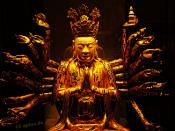Japanese culture and it's relation to Buddhism
Buddhism first touched Japanese society in 552CE, during the visit of the Korean envoy. The brightly colored Buddhist robes that the envoy wore impressed the Japanese aristocrats. Buddhism of this time consisted primarily of an integration of Chinese and Indian thought during trade on the Silk road. When the Japanese aristocrats first encountered Buddhism they were intrigued, but not universally convinced if it could be accepted into Japanese culture. There was a dispute among several influential families who resisted the changes in brought to the existing Shinto religion. However, Buddhism is adaptable. Buddhism's spread can be traced through many countries and it's principles can be linked to the various existing beliefs that those countries had before being touched by Buddhism. The specific form of Buddhism present in Japan is the school of Zen Buddhism. The word Zen is used to describe a form of Buddhism that links meditation with the discovery of self nature.
When Zen arrived in Japan it acquired the refined traditions of Japanese culture. It became totally intertwined with Japanese art, with Zen influencing art and art influencing Zen.
One of the strongly influential schools of art in Japan is the "one corner" style, originated by the artist Bayen. This form of art emphasized the "thrifty brush" or an emphasis on minimalism. The emphasis on simplicity in this form of art is strongly influenced by the Buddhist principle of shunyata, or emptiness. Shunyata teaches that everything lacks self nature, because everything is impermanent. When you just allow a thing to be, you are able to see it's interconnectedness with other things. The one corner style of Japanese art helps present a sort of aloof imperfection that shunyata embodies. "Where you would ordinarily expect a line or a mass or a...


